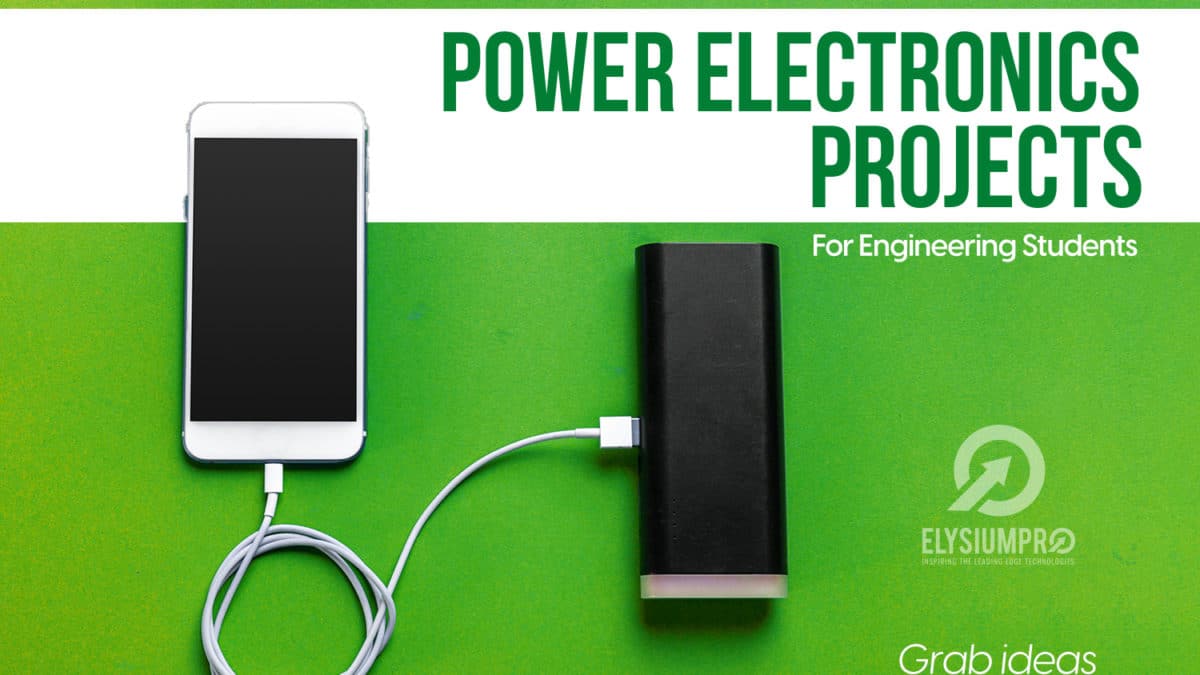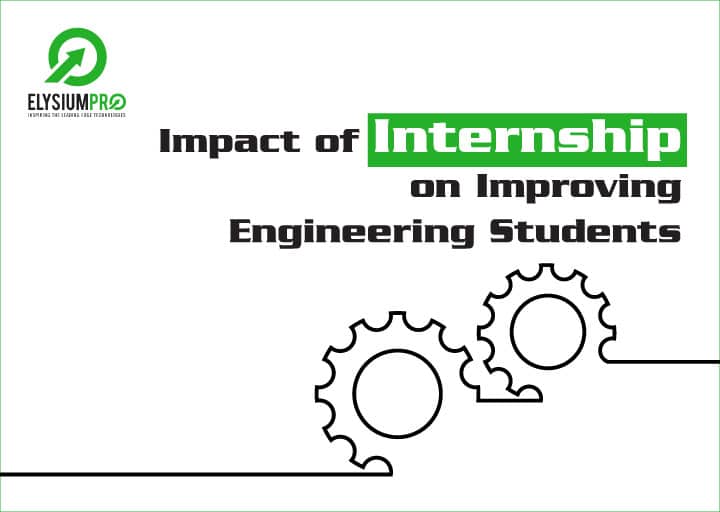
Impact of Internship on Improving Engineering Students
January 22, 2021
3 Wireless Domain Shaping Future Scope of Wireless Networking Projects
November 18, 2022Power Electronics based Projects: Power electronics has become a rapidly developing electrical engineering domain, and this technology covers a wide spectrum of electronic converters. Power electronics deals with controlling the flow of electrical energy- ranked at a power level sooner than a signal level. Its control with the help of solid-state-electronic switches and other control systems. High efficiency, smaller size, lower expense, and lesser weight for converting electrical energy from one form to another are benefits of power electronic devices. In addition, power electronics can convert, figure, and control extensive amounts of power. The application zones of power electronics projects are linear induction motor controls, power system equipment, industrial controlling devices, and so on.
Table of Contents
What is Power Electronics Based Projects?
Power Electronics Projects are especially used in Electronics and
Communication Engineering Industry Sector. Content of Power Electronics Projects is to Transform Milli Watts into Mega Watts. Due to improved switching technologies and the demand for more suitable switching circuits, power electronics projects have some essential rules. Providing significant power at high capacity by producing converters of consolidated size and weight is the target of the latest converter technology. The procedure of the electronic knowledge area deals with devices and circuits. The power field does both rotating and inactive equipment.
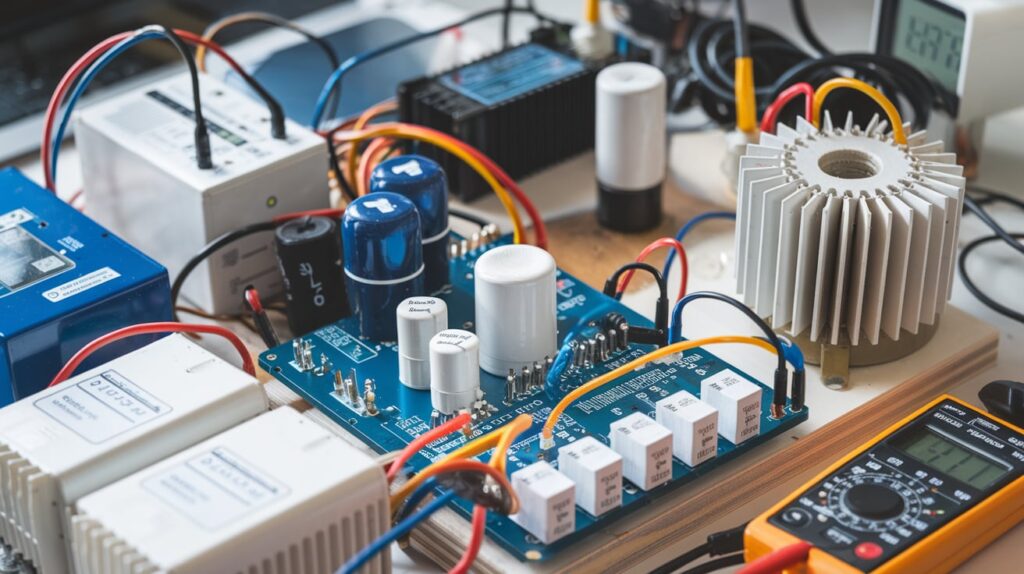
Power Electronics Based Projects are fundamental in modern electrical engineering, driving innovation in energy conversion, control systems, electric vehicles, renewable energy, and industrial automation. These systems operate by converting electrical power efficiently using semiconductor devices and control techniques. To build reliable and high-performing projects, certain tools and characteristics are indispensable.
Let’s explore the essential features and components that form the backbone of any successful Power Electronics Based Project.
1. High Reliability
Reliability is crucial in any power electronics system. Projects must perform consistently over time, especially in mission-critical applications like power grids or electric vehicles.
- Why it matters: Frequent failures can lead to costly downtimes and safety hazards.
- Implementation: Use components rated for extended temperature ranges, long life cycles, and fail-safe design practices.
In Power Electronics Based Projects, high-reliability design ensures that systems can function without interruption even under harsh or fluctuating conditions.
2. Rugged Operation
Ruggedness refers to a system’s ability to operate in extreme or unstable environments—such as high temperatures, vibrations, or electrical noise.
- Key Components: Heat sinks, protective enclosures, surge protectors, and robust PCBs.
- Applications: Defense systems, solar inverters, and industrial drives often demand rugged designs.
Rugged operation is a hallmark of well-designed Power Electronics Based Projects, ensuring durability and field performance in challenging conditions.
3. Low Device Cost
While performance is key, affordability also plays a big role—especially for students and prototype developers.
- Cost-Efficient Devices: MOSFETs, IGBTs, and microcontrollers like Arduino and STM32 are powerful yet budget-friendly.
- Strategy: Optimize designs by selecting components that offer the best trade-off between cost, performance, and availability.
For educational or scalable Power Electronics Based Projects, minimizing device costs without compromising functionality is essential.
4. Fast Switching
Switching speed affects the efficiency, size, and heat dissipation of power electronics systems.
- Importance: Faster switching leads to reduced energy loss and smaller passive components.
- Tools: Use high-speed MOSFETs or GaN transistors, along with efficient gate drivers like IR2110 or DRV8353.
Fast switching is vital in Power Electronics Based Projects that require high efficiency, such as DC-DC converters, electric vehicle controllers, and solar MPPT circuits.
5. High Current Handling
Power systems often require components that can handle high current without degradation or overheating.
- Components: Use thick PCB traces, low-resistance shunt resistors, and power-rated semiconductors.
- Cooling: Employ active (fans) or passive (heat sinks) cooling methods to manage thermal load.
This feature is particularly relevant in Power Electronics Based Projects like motor drivers, battery chargers, and industrial control panels.
6. Simple Assembly and Repair
Ease of assembly and repair can reduce project build time and improve learning outcomes.
- Modular Design: Use plug-and-play modules and breadboard-compatible PCBs.
- Documentation: Maintain circuit diagrams, part lists, and troubleshooting guides.
For academic or prototype Power Electronics Based Projects, simplicity in assembly enables faster development and easier debugging.
7. High Frequency Operation
Operating at higher frequencies allows systems to use smaller inductors and capacitors, which reduces size and improves transient response.
- Use Cases: High-frequency operation is common in inverters, switch-mode power supplies (SMPS), and wireless charging systems.
- Tools: Choose controllers like TL494, SG3525, or modern digital controllers for precise frequency management.
This feature makes Power Electronics Based Projects more compact, responsive, and energy-efficient.
8. Low Power Losses
Minimizing power loss is critical to ensure thermal efficiency, reduce energy costs, and prolong device lifespan.
- Techniques:
- Use synchronous rectification
- Minimize parasitic elements in the layout
- Employ soft switching techniques like zero-voltage or zero-current switching
Low power loss is a defining goal in all modern Power Electronics Based Projects, especially those aligned with green energy and sustainability objectives.
Why Choose Power Electronics for Your Final Year Project?
Power Electronics is at the heart of Power Electronics Based Projects modern-day electrical applications. Whether it’s renewable energy systems, electric mobility, or smart grids, these systems rely on efficient power conversion and control.
Key Benefits:
- Strong relevance to renewable and automotive industries
- Involves real-time hardware and software integration
- High demand in R&D, energy, and automation sectors
- Helps students learn circuit simulation, PCB design, and embedded control
Top Power Electronics Based Projects for Final Year Students
Here are some highly recommended Power Electronics Based Projects ideas for final-year engineering students, with a balance of innovation, real-time application, and practical learning.
1. Solar Powered Pure Sine Wave Inverter
- Objective: Design a DC to AC inverter that converts solar energy into a stable sine wave AC output.
- Key Concepts: PWM control, MPPT (Maximum Power Point Tracking), transformer-based isolation.
- Applications: Home solar systems, off-grid power solutions.
2. Electric Vehicle Motor Controller
- Objective: Build a BLDC motor driver using high-efficiency IGBT/MOSFET circuitry.
- Key Concepts: Speed control, regenerative braking, torque modulation.
- Applications: E-bike, e-rickshaw, or hybrid vehicle prototypes.
3. High-Efficiency Buck-Boost DC-DC Converter
- Objective: Design a converter that maintains constant output voltage regardless of load or input fluctuations.
- Key Concepts: Inductor-based switching, feedback control loop.
- Applications: Battery-operated gadgets, robotics, wearable tech.
4. Induction Motor Soft Starter Using SCRs
- Objective: Create a controlled starter for large induction motors to reduce inrush current.
- Key Concepts: Phase angle control, thyristor triggering, current limiting.
- Applications: Industrial motors, HVAC systems.
5. Wireless Power Transfer for Low Power Devices
- Objective: Implement a contactless charging system using resonant inductive coupling.
- Key Concepts: High-frequency AC generation, coil tuning.
- Applications: Wireless chargers for phones, drones, and sensors.
6. IoT-Based Smart Battery Charging System
- Objective: Monitor and control battery charging remotely via an IoT dashboard.
- Key Concepts: AC-DC conversion, voltage/current sensing, IoT integration using ESP32.
- Applications: Smart energy systems, e-scooters, UPS.
7. Single Phase to Three Phase Converter
- Objective: Convert single-phase AC input to simulate three-phase output using microcontroller logic.
- Key Concepts: Pulse generation, phase shifting, inverter logic.
- Applications: Rural areas with limited power infrastructure.
8. Active Power Factor Correction (PFC) Converter
- Objective: Design a converter that improves the power factor of AC loads.
- Key Concepts: Boost topology, feedback control, harmonic minimization.
- Applications: Energy-efficient appliances, power supplies.
9. Dynamic Braking System for DC Motor
- Objective: Implement an energy-dissipative braking mechanism using resistors or battery recharge feedback.
- Key Concepts: Chopper circuits, brake energy control.
- Applications: Elevators, electric drives, automation.
10. Automatic Transformer Tap Changer
- Objective: Build a control system to adjust transformer tap positions based on voltage fluctuations.
- Key Concepts: Relay control, zero crossing detection, AVR integration.
- Applications: Grid voltage regulation, substations.
Tools & Technologies Commonly Used
- Simulation Software: MATLAB/Simulink, Proteus, PSpice, Multisim
- Microcontrollers: Arduino, PIC, STM32, ESP32
- Power Components: IGBTs, MOSFETs, SCRs, Gate Drivers
- Measurement: Digital Oscilloscope, Multimeter, Current Sensors (ACS712)
- PCBs and Prototyping: KiCad, Eagle, breadboards, custom PCB fabrication
Classifications of Power Electronics Based Projects
The Power Electronics Based Projects soundness and response features of closed-loop systems on a successive or sampled data basis are the fields done by the control area.
Power Transmission
- HVAC.
- HVDC.
High-frequency power conversion
- DC/DC, inverters.
Power Grade.
- Harmonic reduction.
- Power factor correction.
- Active filtering.
- Passive filtering.
- Power devices.
- Distributed power systems.
Structure Blocks of Power Electronics Projects
Power-Electronics-Projects
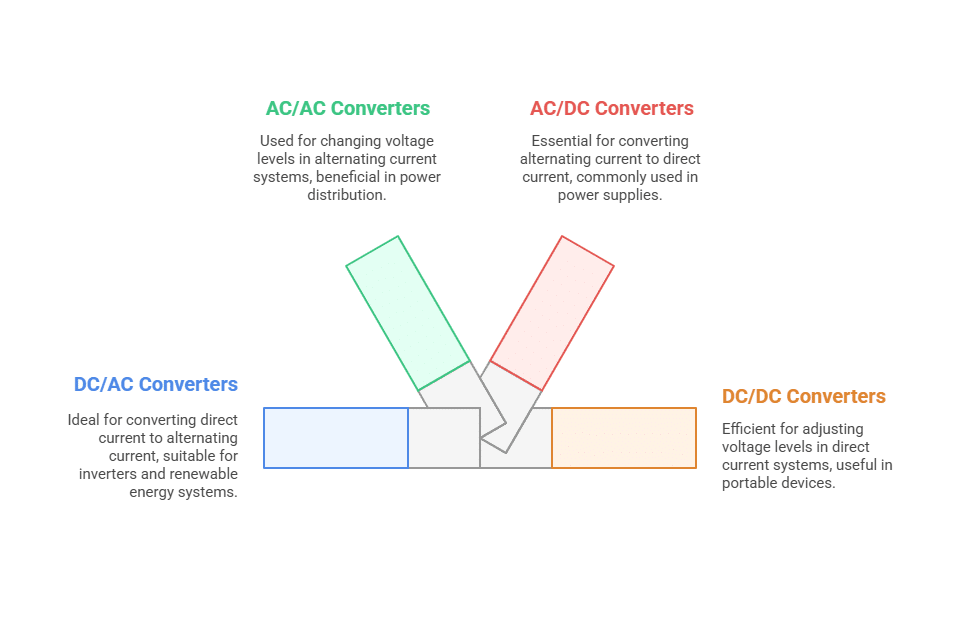
- DC/AC converters.
- AC/AC converters.
- AC/DC converters.
- DC/DC converters.
1. DC/AC Converters (Inverters)
DC/AC converters, also known as inverters, convert direct current (DC) into alternating current (AC). These systems are essential in applications where devices or systems operate on AC power but are powered by DC sources like batteries or solar panels.
Key Features:
- Converts fixed or variable DC input into controlled AC output.
- Output magnitude and frequency can be adjusted for specific load requirements.
- Galvanic isolation is often achieved using a transformer, ensuring safety and eliminating ground loops.
Applications in Power Electronics Based Projects:
- Solar photovoltaic (PV) inverters.
- Uninterruptible power supplies (UPS).
- Electric vehicle traction inverters.
- Induction heating systems.
Project Idea Example:
Design a pure sine wave inverter with transformer-based isolation to power household appliances from a solar DC source.
2. AC/AC Converters
AC/AC converters change one form of alternating current to another, typically involving modifications in frequency, voltage (magnitude), phase, or power characteristics. These converters often use an intermediate DC link, allowing better control and efficiency.
Key Features:
- Capable of changing the input AC to a different output AC with controlled parameters.
- Usually consists of a rectifier + DC link + inverter.
- Suitable for variable frequency applications.
Applications in Power Electronics Based Projects:
- Variable frequency drives (VFDs) for motor control.
- Speed control of induction motors.
- Frequency changers for aircraft or rail systems.
Project Idea Example:
Develop a 3-phase AC to variable-frequency AC converter for industrial motor control using IGBT-based rectification and sinusoidal PWM.
3. AC/DC Converters (Rectifiers)
AC/DC converters, commonly called rectifiers, are responsible for converting AC input into regulated or unregulated DC output. This process is foundational for almost all electronics, from mobile chargers to large-scale industrial systems.
Key Features:
- Converts single-phase or three-phase AC to DC.
- Includes components like diodes, thyristors, or controlled rectifiers.
- Regulates voltage and current depending on load requirements.
Applications in Power Electronics Based Projects:
- Battery charging systems.
- LED lighting systems.
- DC drives for motors.
- Power supply units (SMPS).
Project Idea Example:
Design a controlled rectifier circuit with feedback-based voltage regulation for industrial DC motor control.
4. DC/DC Converters
DC/DC converters are used to convert one DC voltage level to another. They are essential in embedded systems, electric vehicles, robotics, and portable devices.
Key Techniques:
- Switching choppers: Highly efficient, suitable for step-up (boost), step-down (buck), or both (buck-boost) operations.
- Linear regulation: Offers noise-free output but is less efficient due to power dissipation.
Applications in Power Electronics Based Projects:
- Voltage regulation for microcontrollers.
- DC power distribution in EVs.
- Solar charge controllers.
- Battery management systems (BMS).
Project Idea Example:
Build a buck-boost DC/DC converter for a battery-powered drone to regulate voltage and extend flight time.
Some Latest Power Electronics Projects for Engineering Students
Downward mentioned are some power electronics projects that will benefit electrical and electronics engineering, students. Each final year project defined below can be used for a vast range of applications.
DC-LINK CAPACITOR CURRENT RIPPLE REDUCTION IN DPWM-BASED BACK-TO-BACK CONVERTERS
The dependability of Power Electronics Based Projects electronic power converters is a significantly essential feature in industrial applications. However, transformation systems operated in the industry are subject to additional stress types, including temperature deviation, oscillation, radiation and humidity. Furthermore, in expansion, the capacitor is the most powerless part in power converters and is responsible for roughly 30% of collapses during power conversion.
A CAPACITOR VOLTAGE-BALANCING METHOD FOR NESTED NEUTRAL POINT CLAMPED (NNPC) INVERTER
A capacitor Power Electronics Based Projects voltage balancing method for a nested neutral point clamped (NNPC) inverter is presented. The NNPC inverter is a recently formed four-level voltage source inverter (VSI) for medium voltage (MV) applications with effects such as working over a vast range of voltages (2.4-7.2KV) without the essential for clamping power semiconductors in series and high-quality output voltage.
The NNPC topology has two flying capacitors in each portion. To confirm the inverter can operate usually and all switching devices transmit exact voltage stress, the voltage across apiece capacitor should be controlled and had at one-third of dc bus voltage. The suggested capacitor voltage balancing method exploits redundancy in phase switching Power Electronics Based Projects states to control and balance flying capacitor voltages. Uncomplicated and sufficient logic tables are designed for balancing control.
The presented method is Power Electronics Based Projects effortless to implement and requires very few calculations. Moreover, the method is convenient and easy to combine with additional pulse width modulation (PWM) schemes. Simulation and experiment verify the proposed method’s efficacy and feasibility.
SMS Based Electric Billing System Projects:
This SMS established project’s main suggestion is to make an efficient way of circulating electricity bills to consumers by utilizing the remote system with the service of GSM technology as support in the form of an SMS (text messages). As we cause out, automated reading from the electricity meter is one of the future technologies for learning various types of bills via remote application where no human interference is essential.
Similarly, with this technology, an electric billing system based on SMS can be employed to distribute the bills, gaining time, and its working time is fast; however, Power Electronics Based Projects the physical process is employed for the billing system in the present design. An empowered person will visit every residence and issue a bill based on the reading from the house’s meter. With this process, there is a requirement for a huge amount of human resources.
Power Electronics Enabled Self-X Multi-cell Batteries
A Technique for Smart Batteries: The identical old multi-cell battery method generally uses a preset technique to fix several cells in series and parallel while performing to Power Electronics Based Projects achieve the necessary voltage and current. However, this assured plan leads to low dependability, error toleration, and non-optimal energy translation significance.
This project proposes a new power electronics-allowed self-X, multi-cell battery device. The projected multi-cell battery will mechanically manage itself with the dynamic load/storage market and the status of each cell. The launched battery can self-repair from a breakdown or unusual function of solo or several cells, self-equilibrium from cell state variations, and self optimizes to reach the best possible energy translation significance.
A new cell switch circuit achieves these options, and a good routine battery management scheme is projected in this project. The project blueprint is established by activating and testing a six-by-three cell polymer lithium-ion battery. The projected approach is common and will be available to any sort or size of battery cells.
Three-Level Boost Converter
This project designs a three-level DC to DC boost converter topology for an increased conversion ratio. This topology contains a fixed boost topology and voltage multiplier. However, this boost converter cannot provide a high boost ratio because it contains a high duty cycle and voltage stress. So, this three-level boost converter provides an always high transformation ratio.
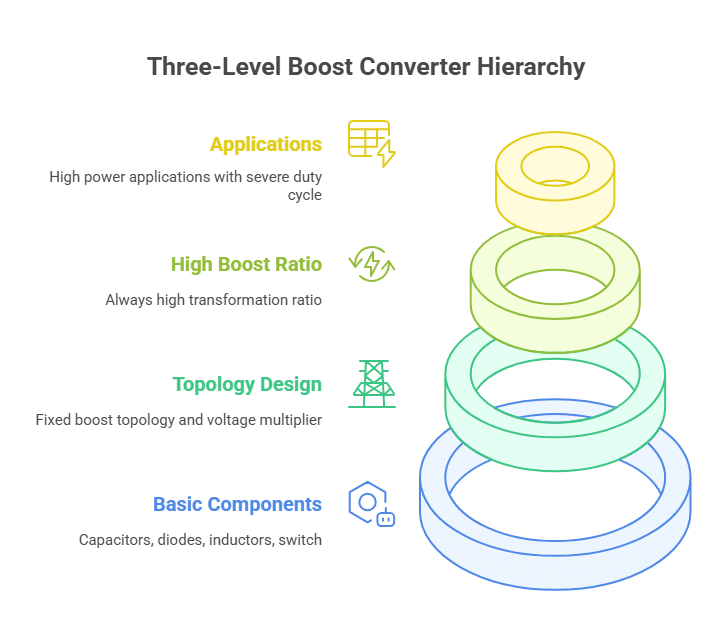
This topology’s main use is improving the output voltage via the diodes and capacitors mixture at the converter output.
This project applies to high power applications by using a severe duty cycle. This converter topology contains capacitors, diodes, inductors & a switch. In addition, this project has formatting parameters like input, output voltage & duty cycle.
Conclusion
Understanding and applying these four converter types DC/AC, AC/AC, AC/DC, and DC/DC—is critical to executing successful Power Electronics Based Projects. Each converter serves unique applications across sectors like renewable energy, transportation, industrial automation, and consumer electronics.
At Elysium Pro, we provide comprehensive support to students and professionals in selecting the right converter architecture, developing efficient circuit designs, and ensuring real-time performance. Whether you’re building a high-frequency inverter or a power-efficient DC-DC converter, our guided project assistance ensures quality and innovation in every step.
FAQs: Power Electronics Based Projects
1. What is the difference between DC/AC and AC/DC converters in Power Electronics Based Projects?
DC/AC converters (inverters) convert direct current into alternating current, commonly used in solar systems and UPS devices. AC/DC converters (rectifiers) convert alternating current into DC, often used in battery chargers and power supplies.
2. Why are DC/DC converters important in battery-powered Power Electronics Based Projects?
DC/DC converters regulate voltage levels efficiently, making them crucial for devices like drones, EVs, and portable electronics where stable power is needed from variable battery outputs.
3. What role does galvanic isolation play in DC/AC converters?
Galvanic isolation protects users and devices by separating the input and output sides using a transformer, enhancing safety and noise immunity in DC/AC converter-based Power Electronics Projects.
4. How does an AC/AC converter differ from using a direct transformer?
While transformers only change voltage, AC/AC converters can modify frequency, phase, and magnitude with higher control and efficiency—ideal for variable speed drives and power quality improvement.
5. Can I use linear regulators instead of switching converters in my DC/DC Power Electronics Project?
Yes, but linear regulators are less efficient and generate more heat. They’re best for low-power, noise-sensitive applications, while switching converters are ideal for energy efficiency and higher power loads.

